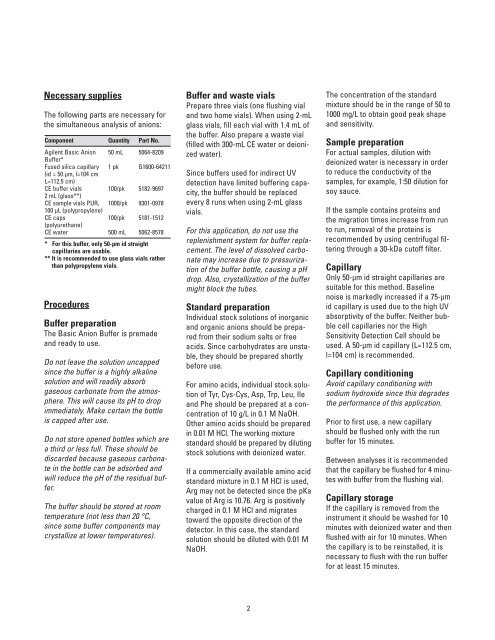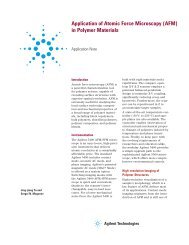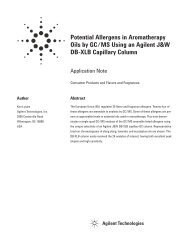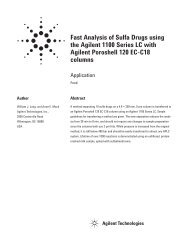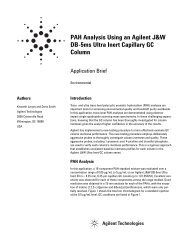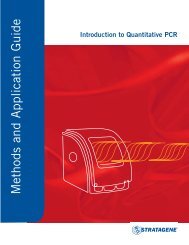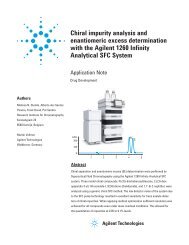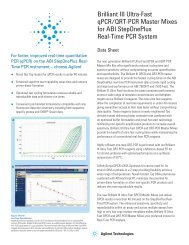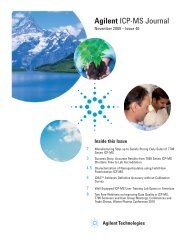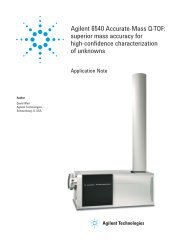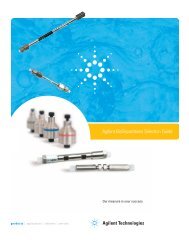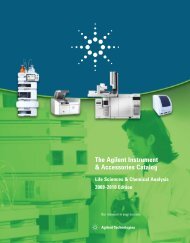Simultaneous analysis of inorganic anions, organic acids, amino ...
Simultaneous analysis of inorganic anions, organic acids, amino ...
Simultaneous analysis of inorganic anions, organic acids, amino ...
You also want an ePaper? Increase the reach of your titles
YUMPU automatically turns print PDFs into web optimized ePapers that Google loves.
Necessary supplies<br />
The following parts are necessary for<br />
the simultaneous <strong>analysis</strong> <strong>of</strong> <strong>anions</strong>:<br />
Component Quantity Part No.<br />
Agilent Basic Anion 50 mL 5064-8209<br />
Buffer*<br />
Fused silica capillary 1 pk G1600-64211<br />
(id = 50 µm, l=104 cm<br />
L=112.5 cm)<br />
CE buffer vials 100/pk 5182-9697<br />
2 mL (glass**)<br />
CE sample vials PUR, 1000/pk 9301-0978<br />
100 µL (polypropylene)<br />
CE caps 100/pk 5181-1512<br />
(polyurethane)<br />
CE water 500 mL 5062-8578<br />
* For this buffer, only 50-µm id straight<br />
capillaries are usable.<br />
** It is recommended to use glass vials rather<br />
than polypropylene vials.<br />
Procedures<br />
Buffer preparation<br />
The Basic Anion Buffer is premade<br />
and ready to use.<br />
Do not leave the solution uncapped<br />
since the buffer is a highly alkaline<br />
solution and will readily absorb<br />
gaseous carbonate from the atmosphere.<br />
This will cause its pH to drop<br />
immediately. Make certain the bottle<br />
is capped after use.<br />
Do not store opened bottles which are<br />
a third or less full. These should be<br />
discarded because gaseous carbonate<br />
in the bottle can be adsorbed and<br />
will reduce the pH <strong>of</strong> the residual buffer.<br />
The buffer should be stored at room<br />
temperature (not less than 20 °C,<br />
since some buffer components may<br />
crystallize at lower temperatures).<br />
Buffer and waste vials<br />
Prepare three vials (one flushing vial<br />
and two home vials). When using 2-mL<br />
glass vials, fill each vial with 1.4 mL <strong>of</strong><br />
the buffer. Also prepare a waste vial<br />
(filled with 300-mL CE water or deionized<br />
water).<br />
Since buffers used for indirect UV<br />
detection have limited buffering capacity,<br />
the buffer should be replaced<br />
every 8 runs when using 2-mL glass<br />
vials.<br />
For this application, do not use the<br />
replenishment system for buffer replacement.<br />
The level <strong>of</strong> dissolved carbonate<br />
may increase due to pressurization<br />
<strong>of</strong> the buffer bottle, causing a pH<br />
drop. Also, crystallization <strong>of</strong> the buffer<br />
might block the tubes.<br />
Standard preparation<br />
Individual stock solutions <strong>of</strong> <strong>in<strong>organic</strong></strong><br />
and <strong>organic</strong> <strong>anions</strong> should be prepared<br />
from their sodium salts or free<br />
<strong>acids</strong>. Since carbohydrates are unstable,<br />
they should be prepared shortly<br />
before use.<br />
For <strong>amino</strong> <strong>acids</strong>, individual stock solution<br />
<strong>of</strong> Tyr, Cys-Cys, Asp, Trp, Leu, Ile<br />
and Phe should be prepared at a concentration<br />
<strong>of</strong> 10 g/L in 0.1 M NaOH.<br />
Other <strong>amino</strong> <strong>acids</strong> should be prepared<br />
in 0.01 M HCl. The working mixture<br />
standard should be prepared by diluting<br />
stock solutions with deionized water.<br />
If a commercially available <strong>amino</strong> acid<br />
standard mixture in 0.1 M HCl is used,<br />
Arg may not be detected since the pKa<br />
value <strong>of</strong> Arg is 10.76. Arg is positively<br />
charged in 0.1 M HCl and migrates<br />
toward the opposite direction <strong>of</strong> the<br />
detector. In this case, the standard<br />
solution should be diluted with 0.01 M<br />
NaOH.<br />
The concentration <strong>of</strong> the standard<br />
mixture should be in the range <strong>of</strong> 50 to<br />
1000 mg/L to obtain good peak shape<br />
and sensitivity.<br />
Sample preparation<br />
For actual samples, dilution with<br />
deionized water is necessary in order<br />
to reduce the conductivity <strong>of</strong> the<br />
samples, for example, 1:50 dilution for<br />
soy sauce.<br />
If the sample contains proteins and<br />
the migration times increase from run<br />
to run, removal <strong>of</strong> the proteins is<br />
recommended by using centrifugal filtering<br />
through a 30-kDa cut<strong>of</strong>f filter.<br />
Capillary<br />
Only 50-µm id straight capillaries are<br />
suitable for this method. Baseline<br />
noise is markedly increased if a 75-µm<br />
id capillary is used due to the high UV<br />
absorptivity <strong>of</strong> the buffer. Neither bubble<br />
cell capillaries nor the High<br />
Sensitivity Detection Cell should be<br />
used. A 50-µm id capillary (L=112.5 cm,<br />
l=104 cm) is recommended.<br />
Capillary conditioning<br />
Avoid capillary conditioning with<br />
sodium hydroxide since this degrades<br />
the performance <strong>of</strong> this application.<br />
Prior to first use, a new capillary<br />
should be flushed only with the run<br />
buffer for 15 minutes.<br />
Between analyses it is recommended<br />
that the capillary be flushed for 4 minutes<br />
with buffer from the flushing vial.<br />
Capillary storage<br />
If the capillary is removed from the<br />
instrument it should be washed for 10<br />
minutes with deionized water and then<br />
flushed with air for 10 minutes. When<br />
the capillary is to be reinstalled, it is<br />
necessary to flush with the run buffer<br />
for at least 15 minutes.<br />
2


